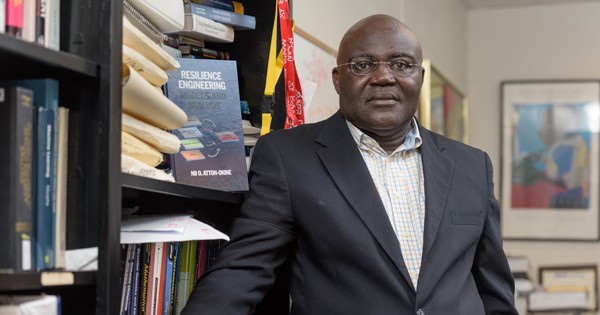UD professor writes book on big data for railway engineers
After two trains derailed at New York’s Penn Station this year, Amtrak blamed track defects. As of May 31, there have been 662 train accidents this year, and track defects account for nearly 29 percent of them, according to the Federal Railroad Administration.
A University of Delaware professor says “big data”—the science of studying large data sets—could help engineers build better railroad tracks.
Nii O. Attoh-Okine, a professor in the Department of Civil and Environmental Engineering, is the author of the recently published book (2017), “Big Data and Differential Privacy: Analysis Strategies for Railway Track Engineering.”
In the book Dr. Attoh-Okine explores the use of tools such as predictive analytics, data mining and machine learning to accomplish useful predictive outputs from the large data sets.
The volume, a reference to help transportation researchers safely and effectively incorporate big data science into the design and management of railroad tracks, is part of the Wiley Series in Operations Research and Management Science. Attoh-Okine says the book is the first of its kind on the use of big data in railway engineering.
So what does big data—an emerging field that relies on high-performance computing—have to do with railroads? Today’s railroads are not like the tracks laid down in the days of Cornelius Vanderbilt.
The railway tracks of the 21st century are embedded with sensors that collect data for safety and operations. For instance, these sensors might be programmed to monitor track alignment or detect unexpected objects on tracks.
“The amount of data being collected is enormous,” says Attoh-Okine.
The challenge is how to gather the data, categorize it, and perform calculations to predict derailments and other problems before they happen.
“In the end, we want safety,” he says.
Attoh-Okine’s book offers frameworks to handle all this information. He uses tools such as predictive analytics, data mining and machine learning.
“Machine learning needs to be applied correctly to capture relevant information from the enormous data collected,” he says.
He also explores privacy issues and analyzes common software programs used in railway track engineering.
Next up: Attoh-Okine plans to explore methods to store the massive amount of data being collected from railroads. Since he finished writing this book, Attoh-Okine has been working on that question, and plans to share some early results at conferences this fall.
Meanwhile, “Big Data and Differential Privacy: Analysis Strategies for Railway Track Engineering” is gaining attention from railway experts.
Prof A.A. (Alfredo) Núñez Vicencio, a faculty member at the Delft University of Technology Section of Railway Engineering, says that this book will be an important resource for his course on railway asset management, particularly when teaches about health condition monitoring in railways and big data.
“The reason is that the book covers many aspects related to the particularities we face in railways when dealing with real-life big data problems,” he says. “It’s a good reference for explaining the general framework, to introduce the challenges of the field, and also when trying to explain more details about sort of methodologies/algorithms/procedures that we are using.”
As a result of the book’s publication, Attoh-Okine has been invited to give a workshop this fall at the China Academy of Railway Sciences in Beijing.
However, this book isn’t just for academics, says Attoh-Okine. It can also serve as reference for professional engineers.

